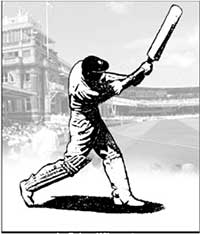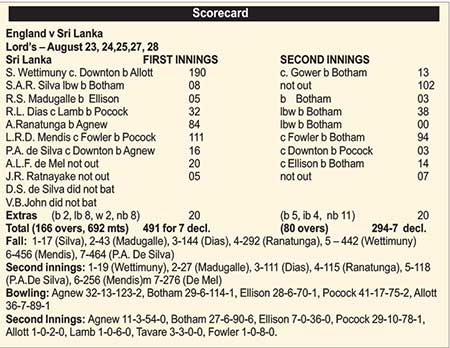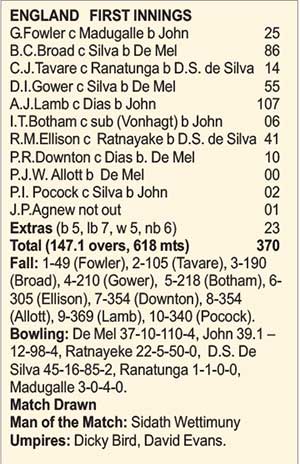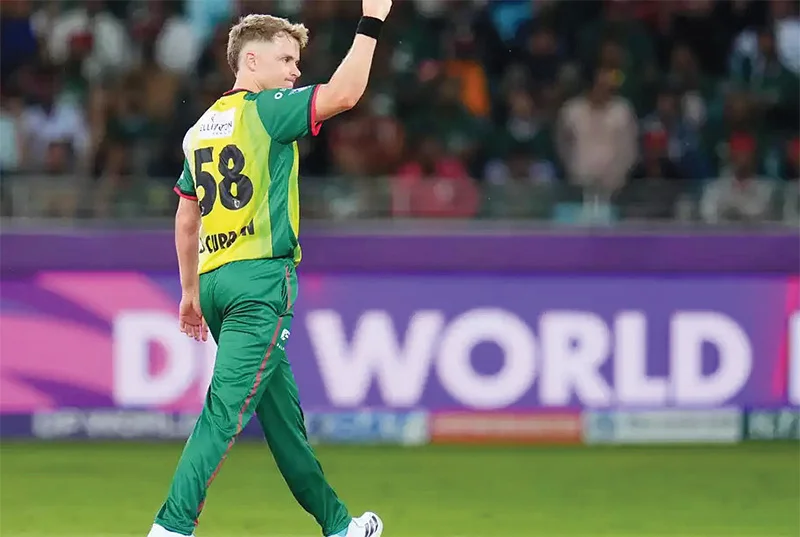Sports
A champagne exit from Lord’s

36th Anniversary of Sri Lanka’s first ever Test match at Lord’s – Part 3
by Rohan Wijeyaratna
The story of this match will serve as a testament not only to the abilities of the 1984 Sri Lankan team, but also to the long cricketing tradition established through the commitment of many generations of past Ceylon cricketers, the country’s wonderful nurseries – the schools, the indefatigable coaches and the clubs that dot the island. All of them played an unseen hand in moulding the Sri Lankan sporting pedigree; an outpouring of which was seen on the first two days at Lord’s. Even though it appeared at the start that there would be only one winner and the game would be one-sided, by the end of day two many were of the view that the most agreeable cricket they witnessed during the entire summer was played on the first two days of this Test at Lord’s and the more deserving side was now on the ascendancy. Denis Compton when I met him at the end of day two put things in perspective. “You chaps today taught us how to bat” he said with disarming candour. There could have been no greater praise, coming from probably England’s finest post war batsman. Others of note – including Tom Graveney expressed similar sentiments. These were indeed heady days for all those who were from the Sri Lankan camp, be they players or spectators alike.
End of two epic innings
There was greater purpose and hurry seen in the Sri Lankan approach when play resumed on Day three. Mendis heaved at anything and everything, while Wettimuny was happy, playing away from his body and relying on his previous day’s form and eye. Something had to give, and it did. Wettimuny forcing Allott on the off from where he stood, managed to deflect a catch behind. That announced the end of an epic feat of endurance which lasted altogether, 642 minutes. It was till then, the longest innings ever in a Test match at Lord’s, and served as the cornerstone upon which the entire innings was built. Shortly thereafter, Mendis heaved at Pocock and holed out to Fowler at long-on. With each of those exits, the crowd rose, as a mark of their appreciation of two magnificently contrasting styles of play which lit up Lord’s in the two preceding days. The applause was long and sustained.

The Sri Lankan intention now appeared plain as pikestaff. De Mel being no mug with the bat, dealt some mighty blows while little Aravinda on his Test debut produced a stroke filled short burst before Mendis declared at 491 for 7. It was the highest ever score by a team playing their maiden Test in England. The closure left Sri Lanka 20 minutes of bowling before lunch.
Posterity might have been better served had the Lankans registered 500 in their very first Test outing at Lord’s, but the decision to close was not without an attacking intent. England were low in form and down in spirit, and to attack them with the new ball on either side of lunch, would give the Lankans their best chance of grabbing some early wickets. Or so they thought.
England’s first requirement was making 292 to avoid the embarrassment of a follow-on. After Fowler had escaped a near catch in the gully to the very first ball from De Mel, Vinothen John bowled a lot of tripe from the other end. It was embarrassing to watch a string of full tosses being delivered at a time when the calling was to put the batsmen under pressure. At lunch, England profiting from this unexpected windfall, were 32 for 0, after 5 overs of rapid batting. With ‘DS’ not making an appearance due to an ankle injury, bleak times portended for the Lankans.
Wretchedly out of form ….
Shortly after resumption, Fowler departed, slicing a catch to second slip. That heralded the most extraordinary passage of play in the match. Vinothen John had by now settled down while De Mel kept steaming in, giving all he got. But they both were far from menacing. The third seamer Ratnayake was largely innocuous, while D.S. de Silva making his appearance only after lunch, bowled his stock-in- trade top spinners nursing a sprained ankle. Against an attack so debilitated, Tavare and Broad went into near slumber. What followed was perhaps the most forgettable passage of play seen in a Lord’s Test for a long time. In 27 dreary overs between lunch and tea, England advanced by 49 runs, with Broad making 19 of them. Together with Tavare, the pair prodded and pushed with infuriating ordinariness, while making the Sri Lankan bowlers seem twice as threatening as they actually were. The batsmen were so out of touch, they allowed ample time and opportunity for a hopelessly ill tuned Sri Lankan attack to find its feet and some rhythm. Tavare having batted toothlessly for 20 overs, advanced to 12 by tea and when he finally went shortly after resumption for 14, he left behind the memory of a man who was so wretchedly out of form, he could hardly hit the ball outside the square.
Woodcock said it all….
 Broad not to be outdone was similarly comatose. While surviving two close lbw decisions from a tireless De Mel, he was twice dropped into the bargain. Gower the new man in, was only marginally better. By close of play 29 overs after tea, the pair had added only 58 runs more to England’s teatime score. The crowd expressed their disapproval unreservedly with some heavy barracking rarely heard at Lord’s. The two sessions since lunch had produced only 107 runs against an attack that was out of fitness and out of form. England were 139 for 2 by the close, with only 105 runs coming off their last 56 overs. John Woodcock writing in the ‘Daily Telegraph’ said “No self-respecting club side would have been content with the way England batted”. And that said it all.
Broad not to be outdone was similarly comatose. While surviving two close lbw decisions from a tireless De Mel, he was twice dropped into the bargain. Gower the new man in, was only marginally better. By close of play 29 overs after tea, the pair had added only 58 runs more to England’s teatime score. The crowd expressed their disapproval unreservedly with some heavy barracking rarely heard at Lord’s. The two sessions since lunch had produced only 107 runs against an attack that was out of fitness and out of form. England were 139 for 2 by the close, with only 105 runs coming off their last 56 overs. John Woodcock writing in the ‘Daily Telegraph’ said “No self-respecting club side would have been content with the way England batted”. And that said it all.
England had the whole of the rest day to digest all the scorn heaped upon them in all forms of the media and bar room conversations. And if one thought there would be a reformed approach to entertain the sparse crowd on Monday, they were mistaken. In fact, by the end of the 4th day, it was generally felt that those who had stayed away from the cricket had been wise; they hadn’t missed much at all.
Lacked imagination
When play resumed on day four Broad and Gower played as though their intention was to bat out the entire day; never mind the prevailing crowd sentiment. England made 71 in the morning session for the loss of Broad shortly before lunch. When De Mel removed Gower with the second new ball shortly after lunch and Botham soon followed, England were 218 for five; still some distance away from avoiding the follow on.
England averted that ignominy through a Lamb – Ellison partnership which realised 87 priceless runs together. Lamb grassed by the keeper when on 36, went on to complete his 4th Test hundred of the summer and when Ellison went for 41, the tireless De Mel accounted for both Downton and Allott in successive balls. With the exit of Pocock and then Lamb off the last ball of the day England were all out for 370, and were trailing Sri Lanka by 121 runs with one more day to go.
 Had England the imagination or desire to give themselves the slightest sniff at a possible chance of victory, they might have rotated the strike and pushed up the run rate, allowing themselves the opportunity to declare sometime after the follow on was averted. But Gower ‘s intransigence and lack of enterprise had been a feature throughout the match. Accordingly, Sri Lanka went into the fifth day, knowing full well the game would only be one of academic interest. Allott pulling a muscle left the proceedings after only one over, while Agnew’s front foot was eternally at odds with the popping crease. This meant that Pocock had to manfully bear the brunt of the attack, along with Botham who was finally reduced to bowling off spin to men adept at playing them in their sleep. That he captured six of the seven wickets to fall may not fully reflect the merit of his performance, although initially, he found some rhythm and swing and snaked a few past the defense of some of the early batsmen. During this effort, Botham surpassed both Fred Trueman and Lance Gibbs’ Test wicket hauls and became the third in line, behind Dennis Lillee and Bob Willis in the all time highest wicket takers’ list at the time. With the 80th over bowled, Sri Lanka declared, to bring to a close a game which was meandering without purpose. It was an ending the tired Englishmen embraced with open arms and a huge sigh of relief.
Had England the imagination or desire to give themselves the slightest sniff at a possible chance of victory, they might have rotated the strike and pushed up the run rate, allowing themselves the opportunity to declare sometime after the follow on was averted. But Gower ‘s intransigence and lack of enterprise had been a feature throughout the match. Accordingly, Sri Lanka went into the fifth day, knowing full well the game would only be one of academic interest. Allott pulling a muscle left the proceedings after only one over, while Agnew’s front foot was eternally at odds with the popping crease. This meant that Pocock had to manfully bear the brunt of the attack, along with Botham who was finally reduced to bowling off spin to men adept at playing them in their sleep. That he captured six of the seven wickets to fall may not fully reflect the merit of his performance, although initially, he found some rhythm and swing and snaked a few past the defense of some of the early batsmen. During this effort, Botham surpassed both Fred Trueman and Lance Gibbs’ Test wicket hauls and became the third in line, behind Dennis Lillee and Bob Willis in the all time highest wicket takers’ list at the time. With the 80th over bowled, Sri Lanka declared, to bring to a close a game which was meandering without purpose. It was an ending the tired Englishmen embraced with open arms and a huge sigh of relief.
Near twin centuries
But that ending came not before another show-piece effort from Mendis who came within a whisker of making twin centuries in his debut Test at Lord’s. Had he done so he would have joined the famous George Headley as only the second in the game’s history to do so. Mendis biffed the bowling with such gay abandon, he made 94 in 97 balls in just over two hours of batting, while reducing Botham to bowling off spin off just two paces, as the effort of a run up wasn’t worth it. Apart from Mendis, the white-helmeted Amal Silva contributed to the score with an unbeaten 102. It was his maiden first class hundred and in only his second Test match.
Unprecedented publicity
No one would deny Sri Lanka’s magnificent showing at Lord’s added considerably to their rising cricketing stock. In fact, no amount of Ambassadors or Politicians could have matched or done more to get their country such creditworthy mention in every single major English newspaper and every single BBC World Service news bulletin for the better part of a week. Had they a more penetrative attack and had their fielding been consistently sharper, the Lankans might have pulled off an improbable win and added to England’s woeful record of losing every single Test match that summer. Though drawn, England were at the receiving end for most of the match and deserved the sobriquet of possibly, the weakest Test team among the seven Test playing nations at the time. While it was an unforgettable Test match for the Sri Lankans, for England the experience was a bolt out of the blue and brought down the curtain on a most forgettable summer.
Sports
Sri Lanka Under 19s pull off two wickets win against Afghanistan

Sri Lanka Under 19s scored back to back victories as Mahanama College batsman Chamika Heenatigala anchored the tail with an unbeaten half century to seal two wickets victory over Afghanistan U19s in their second group match of the Under 19 Asia Cup in Dubai on Monday.
Chasing 236 runs to win Sri Lanka U19s were eight wickets down for 217 runs in the 48th over but Heenatigala with Rasith Nimsara kept their cool to seal the victory with four balls to spare.
In their chase, Viran Chamuditha top scored with 62 runs and put on a first wicket stand of 55 runs with Dimantha Mahavithana (27).
While Kavija Gamage (34) and Dulnith Sigera (22) made vital contributions with the bat, Sethmika Senevirathne and Sigera took three wickets each.
It was Sri Lanka Youth team’s second consecutive win in the tournament after registering their first win against Nepal.
Sports
Dasun Shanaka’s all-round effort can not hold Vipers

Dasun Shanaka scored an unbeaten 29 and took two wickets but that could not hold Desert Vipers becoming the first team to seal a playoffs spot as they made it six wins out of six on Sunday (December 14) halfway through the league stage of the ILT20 2025-26.
Sam Curran produced an all-round effort as Vipers chased down Dubai Capitals’ 166/4 with five wickets in hand and a ball to spare.
Asked to bat, Capitals lost Shayan Jahangir to Naseem Shah in the third over and were kept on a tight leash by the Vipers pacers in the powerplay, reaching 35/1. Gulbadin Naib and Leus du Plooy then added 39 at close to a run-a-ball before Noor Ahmad removed his Afghanistan teammate. Capitals were 68/2 at the halfway mark and in need of momentum through the second half of the innings.
Du Plooy injected some urgency with two fours off Lockie Ferguson in an over, followed by a six off Naseem Shah to bring up a 38-ball fifty. But Curran turned the innings again with a double-wicket over, dismissing du Plooy and Rovman Powell off successive deliveries. Jordan Cox and Dasun Shanaka, however, ensured a strong finish, striking six fours and three sixes in an unbroken 72-run stand off 40 balls.
Max Holden set the tone in the chase, accounting for six of the seven fours Vipers struck in the powerplay. Fakhar Zaman fell to Mustafizur Rahman in the fifth over but Vipers still reached 50 in six overs. Holden was dismissed for 34 by Haider Ali while attempting a slog sweep, and although Hasan Nawaz struck three sixes, he fell to Waqar Salamkheil to leave Vipers at 88/3 after 10 overs.
Dan Lawrence and Curran steadied the chase with a 32-run stand before Lawrence was dismissed by Shanaka for 20 in the 14th over. In the same over, Shimron Hetmyer struck a four and a six and was later reprieved by Shanaka. A couple of tight overs followed, but Vipers remained in control, needing 31 from the final four overs.
Curran took them closer with two fours off David Willey and a six off Muhammad Jawadullah. With three required in the final over, Hetmyer fell to Shanaka, but Curran finished the chase with a six off the fourth ball, completing a 33-ball fifty to cap a fine all-round performance.
Brief scores:
Dubai Capitals 166/4 in 20 overs (Leus du Plooy 54, Jordan Cox 49*; Sam Curran 2-17)
Desert Vipers
171/5 in 19.4 overs (Sam Curran 52*, Max Holden 34; Dasun Shanaka 2-19)
Sports
Akbar Brothers crowned MBSA A-Division champions

Akbar Brothers Ltd delivered a commanding all-round performance to clinch the ‘A’ Division title at the 33rd MSBA League Basketball Tournament, defeating defending champions Fairfirst Insurance 70–60 in a thrilling final held recently.
Despite a group stage loss to Fairfirst, a revitalized Akbar Brothers team returned for the final with renewed focus, executing a strategic and disciplined game plan with some excellent passing and defense. Akbar Brothers came in with all guns blazing right from the outset. The first quarter was all Akbar’s that stacked up a 13 to 4 lead. Fairfirst mounted a strong challenge in the second quarter, narrowing the margin, but Akbar’s momentum secured a 35–28 lead at halftime, a margin they maintained with composure through to the final whistle.
Dasun Mendis led the charge for Akbar Brothers with 18 points and was named the tournament’s Most Valuable Player (MVP). Chenura De Alwis added 17 points to the tally, while Shehan Udayanga posted a valiant 22 points for Fairfirst. Dimitri Grebe anchored Akbar Brothers with strong leadership, with Hiran Wijesooriya captaining Fairfirst.
Earlier in the tournament Akbar Brothers beat Sampath Bank (82-71), Seylan Bank (91-68) David Pieris (110-78) and Seylan Bank in the semi final (83-60)
The final, held at the Royal College Indoor Sports Complex, saw a vibrant turnout of supporters as Akbar Brothers proved their championship mettle with teamwork, resilience, and clinical execution.
Akbar Brothers – Dimitri Grebe (Captain), Dasun Mendis, Chenura De Alwis, Randil Henry, Taher Akbarally, Selvam Savarimuttu, Franklyn Morais, Sanketha Jayarathne, Jeewan Priyankera , Praneeth Udumalagala, Ajith Kuruppu (Coach), Adrian Gabriel (Asst. Coach)
Fairfirst Insurance – Hiran Wijesooriya (Captain), Shehan Udayanga , Lakshan Kulathunga, Roshan Randima, Arnold Brent, Isuru Perera, Denzil Nicholas, Nimesh Fernando, Keshawa Perera, Charaka Anuhas, Asanga Perera (Coach)
-

 Features7 days ago
Features7 days agoFinally, Mahinda Yapa sets the record straight
-

 Features7 days ago
Features7 days agoHandunnetti and Colonial Shackles of English in Sri Lanka
-

 Business5 days ago
Business5 days agoCabinet approves establishment of two 50 MW wind power stations in Mullikulum, Mannar region
-

 News6 days ago
News6 days agoGota ordered to give court evidence of life threats
-

 Features6 days ago
Features6 days agoCliff and Hank recreate golden era of ‘The Young Ones’
-

 Opinion7 days ago
Opinion7 days agoA national post-cyclone reflection period?
-

 Features6 days ago
Features6 days agoSri Lanka and Global Climate Emergency: Lessons of Cyclone Ditwah
-

 Latest News6 days ago
Latest News6 days agoSri Lanka squad named for ACC Men’s U19 Asia Cup



















